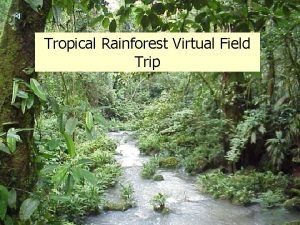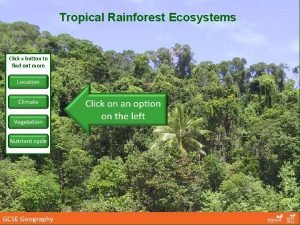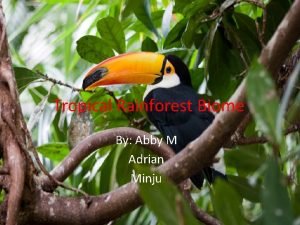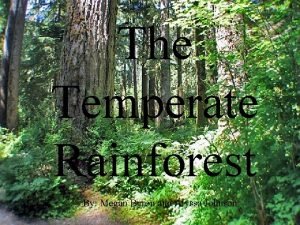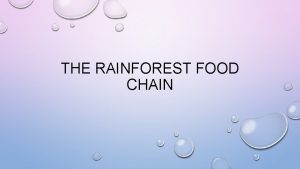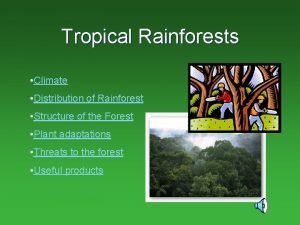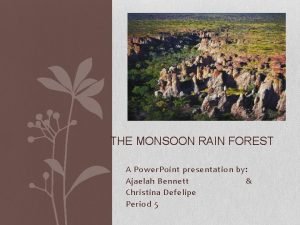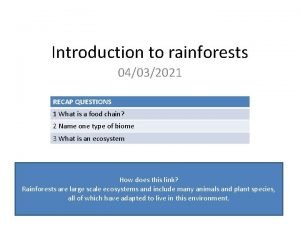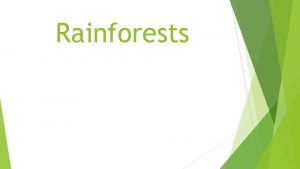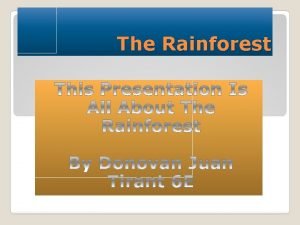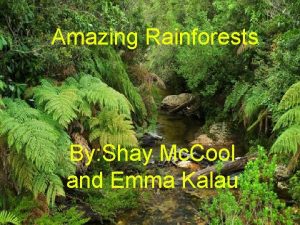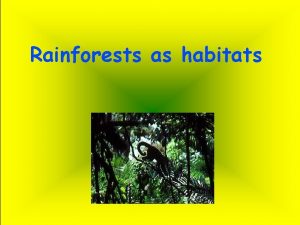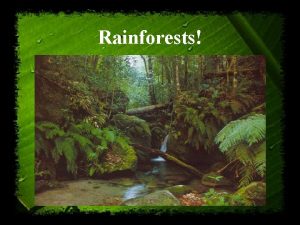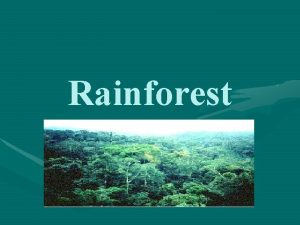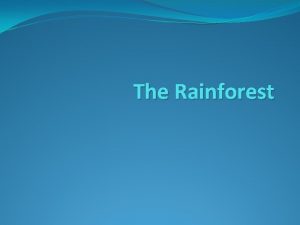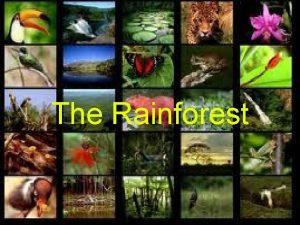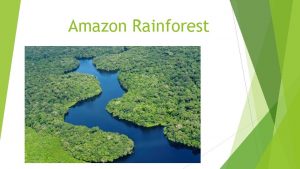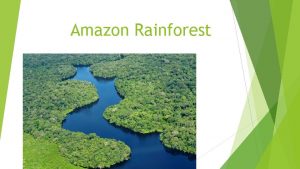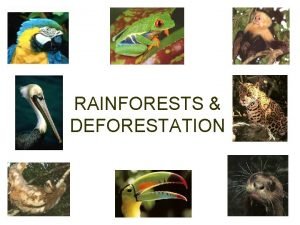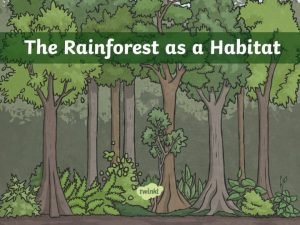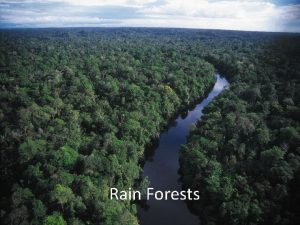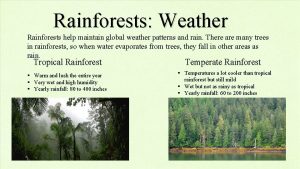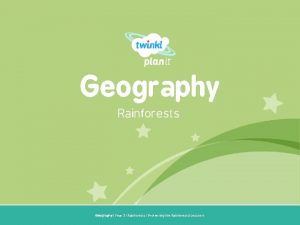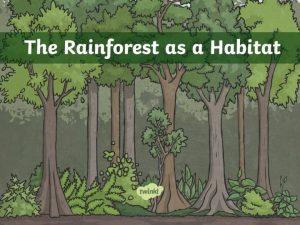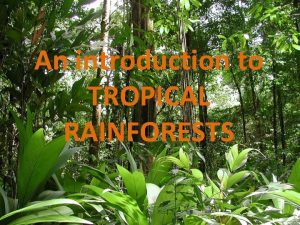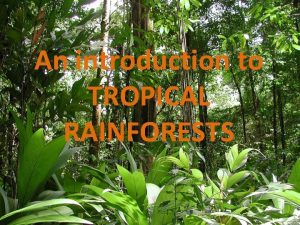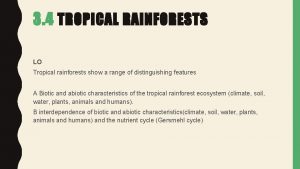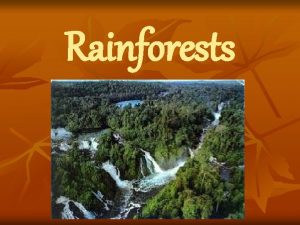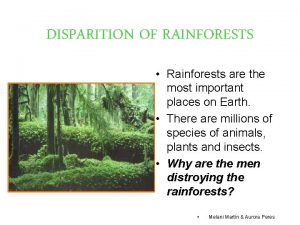Rainforests Rainforests Which is the Largest Rainforest in






















- Slides: 22

Rainforests

Rainforests

Which is the Largest Rainforest in the World? How do we know? What is meant by the term ‘land mass’?

How do we Explain the Location of Tropical Rainforests? One minute to think: What two things do trees need to grow? Sunlight Water

Why Are Rainforests on the Equator? Sunlight Use this diagram to explain why there is a lot of sunlight on the Equator.

Why Are Rainforests on the Equator? Water One minute to think: Quick re-cap, how is rain formed?

The Water Cycle The first step in the water cycle is evaporation. For water to evaporate, it must be warm and in an area of low pressure. High pressure pushes air down Low pressure allows air to rise

The Water Cycle This is a diagram of a Hadley cell. It shows that there is low air pressure over the Equator.

The Water Cycle As there is SUNLIGHT and LOW PRESSURE on the Equator, water can evaporate. This creates a lot of rain.

Summary of what we have just learned: 1. 2. 3. Rainforests need SUNLIGHT and WATER to grow. There is a lot of sunlight on the Equator because the Sun’s rays are concentrated in that area. There is a lot of rain on the Equator because it is warm and there is low air pressure. These are ideal conditions for evaporation, which in turn creates lots of rain.

Activity One

The Tree Tops High up in the tree tops it is sunny and There is no winter in the rainforest, so there are leaves, flowers and fruits to eat all year around. Langurs are leaf-eating monkeys that live in the tree tops. Where there are leaves there are bound to be caterpillars, and the rainforest is full of glorious butterflies. Iguanas are leaf-eating lizards that climb up to feed and sunbathe. There are wonderful fruits in the tree tops. Toucans, hornbills and parrots love to eat them and so do spider monkeys. warm.

The Tree Tops Eagles soar above the canopy looking for birds and monkeys to eat. Many of the animals which live in the tree tops never come down to the ground. If they did, they might not be able to climb back up the smooth tree-trunks. Even ants climb all the way up here to pick leaves and take them down to their nests under the ground. They don’t eat the leaves but use them to grow mushrooms to eat.

Hunters and Killers Predators have to catch and kill other animals to survive. They need to detect their prey before it sees them, to stalk, ambush or outrun it before it escapes, and incapacitate it before it can do them harm. Predators have very acute senses. Predators who hunt during the day rely on their brilliant eyesight to find prey. Nocturnal hunters use other skills, hearing and smell or the ability to detect vibrations made by approaching animals. Prey animals have their own defences and means of avoiding capture, such as camouflage.

Hunters and Killers Leopard Red-Kneed Tarantula As well as dry rocky places, the red-kneed tarantula lives in humid forests. During the day, it stays in its silk lined burrow. After dark, it emerges to hunt for large insects or small invertebrates. It injects prey with venom that quickly causes paralysis. The leopard hunts by leaping on prey from above and killing it with a bite to the throat or neck. Nile Crocodile Lurking unseen in the water, crocodiles are capable of surprising bursts of speed as they lunge forward to grab an animal drinking by the muzzle. They kill their catch by dragging it underwater until it drowns.

Disguise and Warning Animals and insects use camouflage in an effort to avoid being eaten. Colour and shape either make an animal indistinguishable from its background, or trick a predator into thinking it is dealing with something larger and more dangerous. Some animals have colours and patterns that closely match their background. Some patterns seem bold and conspicuous, but actually break up the animal’s outline, making it impossible to see against the mosaic of leaves and twigs. Another kind of camouflage is mimicry, with insects looking like twigs, bark and leaves. The disguise of many insects is so good, rather than wasting their time looking for them, flocks of birds just wave through the forest. What ever small creature one bird knocks off the bird behind snaps up.

Disguise and Warning Camouflage cat Butterflies Light-coloured fur with dark stripes, spots or blotches imitates the dappled effect of sunlight in the dense vegetation of the rainforest. Tigers rely on their ability to remain unseen as they stalk their prey. Many butterflies have vivid patterns to warn predators that they taste unpleasant. Some harmless butterflies copy the appearance of bad tasting ones to trick predators into leaving them alone. Poison arrow frog The bright colours of this frog warn other animals that it is poisonous.

Among the Branches Under the tree tops canopy the vines wind among the tree branches. Everything that lives here has to be an expert climber. Sloth Flying Squirrels They move very slowly. They hang underneath branches, hooked on by their long curved claws. Sloths are rarely the right way up. Tiny plants live right inside the hairs on a sloth, this helps to make them hard to see among the leaves. They sleep in the day in tree holes. They can glide as far as 100 metres between trees. At dusk they climb into the tree tops to feed on plant shoots, leaves and nuts. Some animals can glide from tree to tree instead of leaping. Gliders are easy targets for birds so many of them are patterned to blend in with their surroundings. Most of them only come out at night.

On the Ground On the ground it is warm damp. Everything that falls from above leaves, fruit, animals and droppings are gobbled up by the ants, giant millipedes, beetles and other creatures that swarm there. Nothing is wasted. Even fallen trees are eaten up by termites. On the forest floor scavenging is a way of life. and Because it is so dark, many forest plants and creatures are brightly coloured so that they can be seen. Making noises is another way to attract attention in the dark, and this is the reason rainforests are so noisy. There are not many large animals down here, except for a few scavengers such as wild pigs and tapirs. Tapirs come from the horse and rhinoceros families. They uses their long nose and upper lip in the same way an elephant uses his trunk.

Hidden Dangers Lurking in the depths of the jungle are animals and plant equipped with lethal, foul-tasting poisons. They either make the poison themselves, or use what is in their food. Animals advertise that they are dangerous with bright colours Venomous creatures such as snakes and spiders need powerful venom to subdue prey that might inflict injury during a struggle. Plants contain poison to prevent herbivores from eating their foliage. The only indication that their leaves are poisonous is their bad smell and taste. Animals soon learn not to eat them! .

Hidden Dangers Cobra The cobra is very poisonous. It hunts at dusk and in the early morning. Its front fangs inject a highly toxic venom. The poison is also fatal to people. When threatened, cobras rear up, hiss and puff out their hood. African Giant Swallowtail This is an enormous butterfly, it can have a wingspan up to 10 inches. It is very poisonous and is completely avoided by all its enemies. Poison Plant If a plant loses all its leaves it is unable to take in carbon dioxide and make food. The leaves of the climbing “passion flower” plant contain several poisonous chemicals. Mammals will not eat it.

Task Two
 Where are rainforests located
Where are rainforests located Click to give rainforest
Click to give rainforest Food web in a tropical rainforest
Food web in a tropical rainforest Temperate rainforest
Temperate rainforest Rainforest animal food chain
Rainforest animal food chain Chloe tobin
Chloe tobin Rainforest structure
Rainforest structure Monsoon tropical forest
Monsoon tropical forest Congo rainforest on world map
Congo rainforest on world map What do you already know about rainforests?
What do you already know about rainforests? Rainforest fun fact
Rainforest fun fact Rainforests
Rainforests What is the biggest continent
What is the biggest continent Which atoms has the largest atomic radius
Which atoms has the largest atomic radius Which is the largest country in the europe
Which is the largest country in the europe Which of these quantities represents the largest mass?
Which of these quantities represents the largest mass? Why does atomic radius decrease across a period
Why does atomic radius decrease across a period Stratum basale
Stratum basale Anna bieberdorf
Anna bieberdorf Microvilli
Microvilli Which is the largest gland of the body
Which is the largest gland of the body Pancreatic digestive secretions
Pancreatic digestive secretions Which is the largest gland of the body
Which is the largest gland of the body
